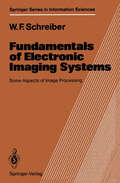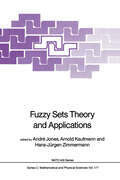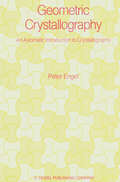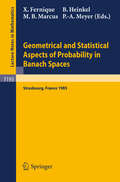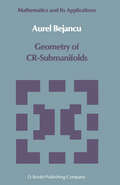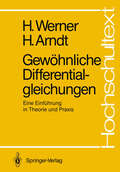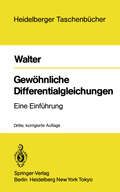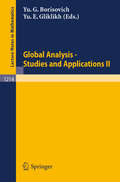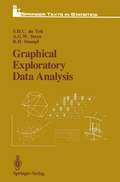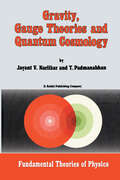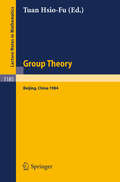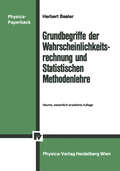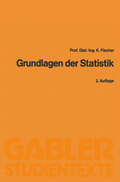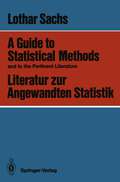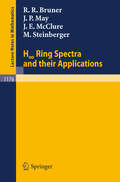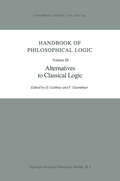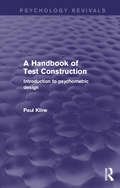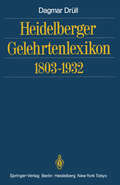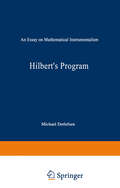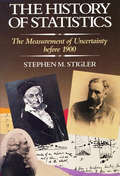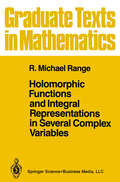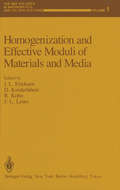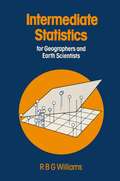- Table View
- List View
Fundamentals of Electronic Imaging Systems: Some Aspects of Image Processing (Springer Series in Information Sciences #15)
by William F. SchreiberImage processing is an applications area. In this area there are many op portunities to apply art and experience, as well as knowledge from various sciences and engineering disciplines, to the creation of products and pro cesses for which society has urgent need. Without this need, few would be interested in the subject. This point of view motivates this work and has influenced the selection and treatment of topics. It will be noticed that the word "digital" is not in the title. While much of present-day image processing is implemented digitally, this work is not intended for those who think that image processing is a branch of digital signal processing, except perhaps to try to change their minds. This book grew out of courses taught at the Massachusetts Institute of Technology by the author and two of his former students, T.S. Huang and O.J. Tretiak. Like the courses, it is primarily intended for electrical engineers and computer scientists who plan to work in the field. It has not proven necessary to spend much time on strictly digital issues, since the students either know that material already or can learn it very easily by 1 themselves. It also has been unnecessary to be encyclopedic, since Pratt has already performed this important service.
Fuzzy Sets Theory and Applications (Nato Science Series C: #177)
by André Jones Arnold Kaufmann Hans-Jürgen ZimmermannProblems in decision making and in other areas such as pattern recogni tion, control, structural engineering etc. involve numerous aspects of uncertainty. Additional vagueness is introduced as models become more complex but not necessarily more meaningful by the added details. During the last two decades one has become more and more aware of the fact that not all this uncertainty is of stochastic (random) cha racter and that, therefore, it can not be modelled appropriately by probability theory. This becomes the more obvious the more we want to represent formally human knowledge. As far as uncertain data are concerned, we have neither instru ments nor reasoning at our disposal as well defined and unquestionable as those used in the probability theory. This almost infallible do main is the result of a tremendous work by the whole scientific world. But when measures are dubious, bad or no longer possible and when we really have to make use of the richness of human reasoning in its variety, then the theories dealing with the treatment of uncertainty, some quite new and other ones older, provide the required complement, and fill in the gap left in the field of knowledge representation. Nowadays, various theories are widely used: fuzzy sets, belief function, the convenient associations between probability and fuzzines~ etc ••• We are more and more in need of a wide range of instruments and theories to build models that are more and more adapted to the most complex systems.
Geometric Crystallography: An Axiomatic Introduction to Crystallography
by P. EngelIn the last decade mathematical crystallography has found increasing interest. Siginificant results have been obtained by algebraic, geometric, and group theoretic methods. Also classical crystallography in three-dimen sional Euclidean space has been extended to higher dimen sions in order to understand better the dimension independent crystallographic properties. The aim of this note is to introduce the reader to the fascinating and rich world of geometric crystallography. The prerequisites for reading it are elementary geometry and topological notations, and basic knowledge of group theory and linear algebra. Crystallography is geometric by its nature. In many cases, geometric arguments are the most appropriate and can thus best be understood. Thus the geometric point of view is emphasized here. The approach is axiomatic start ing from discrete point sets in Euclidean space. Symmetry comes in very soon and plays a central role. Each chapter starts with the necessary definitions and then the subject is treated in two- and three-dimensional space. Subsequent sections give an extension to higher dimensions. Short historical remarks added at the end of the chapters will show the development of the theory. The chapters are main ly self-contained. Frequent cross references, as well as an extended subject index, will help the reader who is only interested in a particular subject.
Geometrical and Statistical Aspects of Probability in Banach Spaces: Actes des Journees SMF de Calcul des Probabilites dans les Espaces de Banach, organisees a Strasbourg les 19 et 20 Juin 1985 (Lecture Notes in Mathematics #1193)
by Xavier Fernique Bernard Heinkel Paul-Andre Meyer Michel MarcusGeometry of CR-Submanifolds (Mathematics and its Applications #23)
by Aurel BejancuApproach your problems from the right end It isn't that they can't see the solution. It is and begin with the answers. Then one day, that they can't see the problem. perhaps you will find the final question. G. K. Chesterton. The Scandal of Father 'The Hermit Clad in Crane Feathers' in R. Brown 'The point of a Pin'. van Gulik's The Chinese Maze Murders. Growing specialization and diversification have brought a host of monographs and textbooks on increasingly specialized topics. However, the "tree" of knowledge of mathematics and related fields does not grow only by putting forth new branches. It also happens, quite often in fact, that branches which were thought to be completely disparate are suddenly seen to be related. Further, the kind and level of sophistication of mathematics applied in various sciences has changed drastically in recent years: measure theory is used (non trivially) in regional and theoretical economics; algebraic geometry interacts with physics; the Minkowsky lemma, coding theory and the structure of water meet one another in packing and covering theory; quantum fields, crystal defects and mathematical programming profit from homotopy theory; Lie algebras are relevant to filtering; and prediction and electrical engineering can us;; Stein spaces. And in addition to this there are such new emerging subdisciplines as "experimental mathematics", "CFD", "completely integrable systems", "chaos, synergetics and large-scale order", which are almost impossible to fit into the existing classification schemes. They draw upon widely different sections of mathematics.
Gewöhnliche Differentialgleichungen: Eine Einführung in Theorie und Praxis (Hochschultext)
by Helmut Werner Herbert ArndtDieses Buch über gewöhnliche Differentialgleichungen ist aus einem Kurs für die Fernhochschule Hagen hervorgegangen, an dem seinerzeit auch Herr Dr. P. Janßen mitgearbeitet hatte. Ziel des damaligen Kurses war es, den Studenten, die ihrer Natur nach nicht so häufig persönlichen Kontakt mit der Hochschule haben, eine Einführung in die Theorie und Praxis der gewöhnlichen Differentialgleichungen in einer Form zu geben, die dem häuslichen Selbststudium entgegenkommt. Dieses Konzept wurde auch in der vorliegenden Darstellung beibehalten. Jedoch kann man bei einer solchen Intention nicht erwarten, daß alle Aspekte der gewöhnlichen Differentialgleichungen auch nur annähernd angesprochen werden können. Dem Leser, der an weiterführenden Themen wie z.B. "Periodische Lösungen" oder "Verzweigungstheorie" interessiert ist, soll das Literaturverzeichnis helfen. Leider hat Herr Werner die endgültige Fertigstellung dieses Buches nicht mehr erleben können - er verstarb im November 1985. Aus der engen Zusammenarbeit mit ihm kann ich jedoch sagen, daß ihm die Anfertigung dieses Buches mit seinem Thema und seiner didaktischen Ausrichtung ein besonderes Anliegen war und er bis zuletzt stets mit Freude daran gearbeitet hat.
Global Analysis. Studies and Applications II (Lecture Notes in Mathematics #1214)
by Yurii G. Borisovich Yuri E. GliklikhGraphical Exploratory Data Analysis (Springer Texts in Statistics)
by S. H. DuToit A. G. Steyn R. H. StumpfPortraying data graphically certainly contributes toward a clearer and more penetrative understanding of data and also makes sophisticated statistical data analyses more marketable. This realization has emerged from many years of experience in teaching students, in research, and especially from engaging in statistical consulting work in a variety of subject fields. Consequently, we were somewhat surprised to discover that a comprehen sive, yet simple presentation of graphical exploratory techniques for the data analyst was not available. Generally books on the subject were either too incomplete, stopping at a histogram or pie chart, or were too technical and specialized and not linked to readily available computer programs. Many of these graphical techniques have furthermore only recently appeared in statis tical journals and are thus not easily accessible to the statistically unsophis ticated data analyst. This book, therefore, attempts to give a sound overview of most of the well-known and widely used methods of analyzing and portraying data graph ically. Throughout the book the emphasis is on exploratory techniques. Real izing the futility of presenting these methods without the necessary computer programs to actually perform them, we endeavored to provide working com puter programs in almost every case. Graphic representations are illustrated throughout by making use of real-life data. Two such data sets are frequently used throughout the text. In realizing the aims set out above we avoided intricate theoretical derivations and explanations but we nevertheless are convinced that this book will be of inestimable value even to a trained statistician.
Gravity, Gauge Theories and Quantum Cosmology (Fundamental Theories of Physics #11)
by J.V. Narlikar T. PadmanabhanFor several decades since its inception, Einstein's general theory of relativity stood somewhat aloof from the rest of physics. Paradoxically, the attributes which normally boost a physical theory - namely, its perfection as a theoreti cal framework and the extraordinary intellectual achievement underlying i- prevented the general theory from being assimilated in the mainstream of physics. It was as if theoreticians hesitated to tamper with something that is manifestly so beautiful. Happily, two developments in the 1970s have narrowed the gap. In 1974 Stephen Hawking arrived at the remarkable result that black holes radiate after all. And in the second half of the decade, particle physicists discovered that the only scenario for applying their grand unified theories was offered by the very early phase in the history of the Big Bang universe. In both cases, it was necessary to discuss the ideas of quantum field theory in the background of curved spacetime that is basic to general relativity. This is, however, only half the total story. If gravity is to be brought into the general fold of theoretical physics we have to know how to quantize it. To date this has proved a formidable task although most physicists would agree that, as in the case of grand unified theories, quantum gravity will have applications to cosmology, in the very early stages of the Big Bang universe. In fact, the present picture of the Big Bang universe necessarily forces us to think of quantum cosmology.
Group Theory: Beijing 1984. Proceedings of an International Symposium Held in Beijing, August 27 - September 8, 1984 (Lecture Notes in Mathematics #1185)
by Hsio-Fu TuanGrundbegriffe der Wahrscheinlichkeitsrechnung und Statistischen Methodenlehre
by H. BaslerVI ten Beispiele und Aufgaben überprüft. Dem Verleger, Herrn Liebing, danke ich flir sein bis in sachliche Einzelheiten gehendes Interesse, das er dem Entstehen dieses Buches entgegengebracht hat. Herbert Basler Würzburg, im April 1968 Vorwort zur 7. Auflage Das Konzept des Buches war und ist, flir Nicht-Mathematiker eine mathematisch saubere, aber soweit wie möglich von mathematischer Technik entlastete Einfüh rung in die Wahrscheinlichkeitsrechnung und angewandte Mathematische Statistik zu bieten. Während der vorangegangenen Auflagen habe ich bemerkt, da'~ auch bei Mathematikern ein Bedürfnis nach einer solchen Einflihrung als einer Propädeutik flir einschlägige rein mathematische Kurse besteht. Insbesondere diese Bindeglied Funktion zwischen mathematischer Theorie und Anwendungen habe ich in der vor liegenden Auflage weiter auszubauen versucht, da ich beispielsweise beobachte, daß es Mathematik-Studenten, die an Kursen für Nicht-Mathematiker teilnehmen, oft nicht mehr möglich ist, die vermeintliche Kluft zwischen so einer Statistischen Me thodenlehre und einer maßtheoretisch fundierten Wahrscheinlichkeitstheorie und Mathematischen Statistik zu überbrücken und den Zusammenhang zu sehen. In die se Richtung gehen die Erweiterungen am Schluß von 1. 4. 3 (S. 48), am Schluß von 2. 1 (Charakterisierungssatz nir Verteilungsfunktionen, S. 65f. ), im neuen Abschnitt 2. 2. 1 (Verwendung des Terminus "Grundgesamtheit", S. 73f. ) sowie der Abschnitt 3. 1 Stichproben. Dabei habe ich vielfach Kleindruck verwendet um "stärker vor wärts drängenden Lesern" die Möglichkeit zu geben, den Faden zu behalten, wenn sie solche Passagen übergehen wollen. Au1\erdem habe ich viele Teile neu formuliert, so z. B.
A Guide to Statistical Methods and to the Pertinent Literature / Literatur zur Angewandten Statistik
by Lothar SachsReaders of my books, students and scientists, often ask for spe cial references not commonly found in introductory or interme diate books on statistics. From the titles and contents of 1449 key papers and books which are listed and numbered in Sec tion 5, I have selected keywords and subject headings and ar ranged them alphabetically together with the numbers of perti nent references in Section 3. Number 1153, for instance, denotes my book" Applied Statis tics". It contains a bibliographical section on pages 568 to 641. Supplementary material is displayed in this small bibliographi cal guide. It also complements well-known textbooks of Box, Hunter and Hunter (No.121), Dixon and Massey (No.286), Snedecor and Cochran (No. 1238), and many recent competitors. Since the methodology of statistics is expanding rapidly, many methods are not considered at all or only introduced in the basic textbooks of statistics. There is a need for intermediate statistical methods concerned with increasingly complicated ap plications of statistics to actual research situations. Here the specification of terms helps to find some sources. Since the ref erences vary considerably in length and content, the number of culled or extracted terms per referenced page varies even more, as does also their degree of specialization; however in most cases an intermediate statistical level is maintained.
H Ring Spectra and Their Applications (Lecture Notes in Mathematics #1176)
by Robert R. Bruner J. Peter May James E. McClure Mark SteinbergerHandbook of Philosophical Logic: Volume III: Alternatives to Classical Logic (Synthese Library #166)
by Dov M. Gabbay Franz GuenthnerThis volume presents a number of systems of logic which can be considered as alternatives to classical logic. The notion of what counts as an alternative is a somewhat problematic one. There are extreme views on the matter of what is the 'correct' logical system and whether one logical system (e. g. classical logic) can represent (or contain) all the others. The choice of the systems presented in this volume was guided by the following criteria for including a logic as an alternative: (i) the departure from classical logic in accepting or rejecting certain theorems of classical logic following intuitions arising from significant application areas and/or from human reasoning; (ii) the alternative logic is well-established and well-understood mathematically and is widely applied in other disciplines such as mathematics, physics, computer science, philosophy, psychology, or linguistics. A number of other alternatives had to be omitted for the present volume (e. g. recent attempts to formulate so-called 'non-monotonic' reason ing systems). Perhaps these can be included in future extensions of the Handbook of Philosophical Logic. Chapter 1 deals with partial logics, that is, systems where sentences do not always have to be either true or false, and where terms do not always have to denote. These systems are thus, in general, geared towards reasoning in partially specified models. Logics of this type have arisen mainly from philo sophical and linguistic considerations; various applications in theoretical computer science have also been envisaged.
A Handbook of Test Construction: Introduction to Psychometric Design (Psychology Revivals)
by Paul KlinePsychological tests provide reliable and objective standards by which individuals can be evaluated in education and employment. Therefore accurate judgements must depend on the reliability and quality of the tests themselves. Originally published in 1986, this handbook by an internationally acknowledged expert provided an introductory and comprehensive treatment of the business of constructing good tests. Paul Kline shows how to construct a test and then to check that it is working well. Covering most kinds of tests, including computer presented tests of the time, Rasch scaling and tailored testing, this title offers: a clear introduction to this complex field; a glossary of specialist terms; an explanation of the objective of reliability; step-by-step guidance through the statistical procedures; a description of the techniques used in constructing and standardizing tests; guidelines with examples for writing the test items; computer programs for many of the techniques. Although the computer testing will inevitably have moved on, students on courses in occupational, educational and clinical psychology, as well as in psychological testing itself, would still find this a valuable source of information, guidance and clear explanation.
A Handbook of Test Construction: Introduction to Psychometric Design (Psychology Revivals)
by Paul KlinePsychological tests provide reliable and objective standards by which individuals can be evaluated in education and employment. Therefore accurate judgements must depend on the reliability and quality of the tests themselves. Originally published in 1986, this handbook by an internationally acknowledged expert provided an introductory and comprehensive treatment of the business of constructing good tests. Paul Kline shows how to construct a test and then to check that it is working well. Covering most kinds of tests, including computer presented tests of the time, Rasch scaling and tailored testing, this title offers: a clear introduction to this complex field; a glossary of specialist terms; an explanation of the objective of reliability; step-by-step guidance through the statistical procedures; a description of the techniques used in constructing and standardizing tests; guidelines with examples for writing the test items; computer programs for many of the techniques. Although the computer testing will inevitably have moved on, students on courses in occupational, educational and clinical psychology, as well as in psychological testing itself, would still find this a valuable source of information, guidance and clear explanation.
Hilbert’s Program: An Essay on Mathematical Instrumentalism (Synthese Library #182)
by M. DetlefsenHilbert's Program was founded on a concern for the phenomenon of paradox in mathematics. To Hilbert, the paradoxes, which are at once both absurd and irresistible, revealed a deep philosophical truth: namely, that there is a discrepancy between the laws accord ing to which the mind of homo mathematicus works, and the laws governing objective mathematical fact. Mathematical epistemology is, therefore, to be seen as a struggle between a mind that naturally works in one way and a reality that works in another. Knowledge occurs when the two cooperate. Conceived in this way, there are two basic alternatives for mathematical epistemology: a skeptical position which maintains either that mind and reality seldom or never come to agreement, or that we have no very reliable way of telling when they do; and a non-skeptical position which holds that there is significant agree ment between mind and reality, and that their potential discrepan cies can be detected, avoided, and thus kept in check. Of these two, Hilbert clearly embraced the latter, and proposed a program designed to vindicate the epistemological riches represented by our natural, if non-literal, ways of thinking. Brouwer, on the other hand, opted for a position closer (in Hilbert's opinion) to that of the skeptic. Having decided that epistemological purity could come only through sacrifice, he turned his back on his classical heritage to accept a higher calling.
The History of Statistics: The Measurement of Uncertainty before 1900
by Stephen M. StiglerThis magnificent book is the first comprehensive history of statistics from its beginnings around 1700 to its emergence as a distinct and mature discipline around 1900. Stephen M. Stigler shows how statistics arose from the interplay of mathematical concepts and the needs of several applied sciences including astronomy, geodesy, experimental psychology, genetics, and sociology. He addresses many intriguing questions: How did scientists learn to combine measurements made under different conditions? And how were they led to use probability theory to measure the accuracy of the result? Why were statistical methods used successfully in astronomy long before they began to play a significant role in the social sciences? How could the introduction of least squares predate the discovery of regression by more than eighty years? On what grounds can the major works of men such as Bernoulli, De Moivre, Bayes, Quetelet, and Lexis be considered partial failures, while those of Laplace, Galton, Edgeworth, Pearson, and Yule are counted as successes? How did Galton’s probability machine (the quincunx) provide him with the key to the major advance of the last half of the nineteenth century? Stigler’s emphasis is upon how, when, and where the methods of probability theory were developed for measuring uncertainty in experimental and observational science, for reducing uncertainty, and as a conceptual framework for quantitative studies in the social sciences. He describes with care the scientific context in which the different methods evolved and identifies the problems (conceptual or mathematical) that retarded the growth of mathematical statistics and the conceptual developments that permitted major breakthroughs. Statisticians, historians of science, and social and behavioral scientists will gain from this book a deeper understanding of the use of statistical methods and a better grasp of the promise and limitations of such techniques. The product of ten years of research, The History of Statistics will appeal to all who are interested in the humanistic study of science.
Holomorphic Functions and Integral Representations in Several Complex Variables (Graduate Texts in Mathematics #108)
by R. Michael RangeThe subject of this book is Complex Analysis in Several Variables. This text begins at an elementary level with standard local results, followed by a thorough discussion of the various fundamental concepts of "complex convexity" related to the remarkable extension properties of holomorphic functions in more than one variable. It then continues with a comprehensive introduction to integral representations, and concludes with complete proofs of substantial global results on domains of holomorphy and on strictly pseudoconvex domains inC", including, for example, C. Fefferman's famous Mapping Theorem. The most important new feature of this book is the systematic inclusion of many of the developments of the last 20 years which centered around integral representations and estimates for the Cauchy-Riemann equations. In particu lar, integral representations are the principal tool used to develop the global theory, in contrast to many earlier books on the subject which involved methods from commutative algebra and sheaf theory, and/or partial differ ential equations. I believe that this approach offers several advantages: (1) it uses the several variable version of tools familiar to the analyst in one complex variable, and therefore helps to bridge the often perceived gap between com plex analysis in one and in several variables; (2) it leads quite directly to deep global results without introducing a lot of new machinery; and (3) concrete integral representations lend themselves to estimations, therefore opening the door to applications not accessible by the earlier methods.
Homogenization and Effective Moduli of Materials and Media (The IMA Volumes in Mathematics and its Applications #1)
by Jerry L. Ericksen David Kinderlehrer Robert Kohn J. L. LionsThis IMA Volume in Mathematics and its Applications Homogenization and Effective Moduli of Materials and Media represents the proceedings of a workshop which was an integral part of the 19R4-R5 IMA program on CONTINUUM PHYSICS AND PARTIAL DIFFERENTIAL EQUATIONS. We are grateful to the Scientific Committee: J . L. Ericksen D. Kinderlehrer H. Brezis C. Dafermos for their dedication and hard work in rleveloping an imaginative, stimulating, and productive year-long program. George R. Sell Hans Weinherger PREFACE The papers in this volume were presented at a workshop on homogenization of differential equations and the determination of effective moduli of materials and media, primarily in the context of continuum theory. These areas are closely linked to a variety of phenomena, such as the elastic and dielectric responses of composites, and the effective properties of shales and soils. For instance, the ability to predict the effective stiffness response of a composite across a broad range of frequencies allows its performance under given circumstances to be assessed by means of nondestructive testing. A fundamental mathematical tool is homogenization, the study of partial differential equations with rapidly varying coefficients or boundary conditions. The recent alliance of homogenization with optimal design has stimulated the development of both fields. The presentations at the workshop emphasized recent advances and open questions.
Immunology and Epidemiology: Proceedings of an International Conference held in Mogilany, Poland, February 18–25, 1985 (Lecture Notes in Biomathematics #65)
by Geoffrey W. Hoffmann Tomas HrabaIn February 1985 a small international meeting of scientists took place at the recreation resort of the Polish Academy of Sci ences in Mogilany, near Cracow, Poland. The initiative for holding the workshop came from a working meeting on mathematical immunology and related topics at the International Institute for Applied Sys tems Analysis in Laxenburg, Austria, in November 1983. In addition to representatives of IIASA, delegates of the IIASA National Member Organizations (NMO) of Czechoslovakia, Italy, and the soviet Union took part in that working meeting. The participants came to the conclusion that IIASA could play an important role in facilitating the development of research in this field. The first step that they recommended to I IASA was to organize a workshop on mathematical immunology. The purpose of the workshop was to review the progress that has been made in applying mathematics to problems in immunology and to explore ways in which further progress might be achieved, especially by more efficient interactions between scientists working in mathematical and experimental immunology. Some National Member Organizations contributed to the success of the workshop by nominat ing further participants working in this or related fields. For instance, thanks to a suggestion of the British NMO, the meeting also included analyses of the interactions between the immune state of a population and epidemiological phenomena. There were 33 participants at Mogilany from 11 countries, namely Canada, Czechoslovakia, Federal Republic of Germany, Hungary, Japan, Netherlands, Poland, Sweden, united Kingdom, USA, and USSR.
